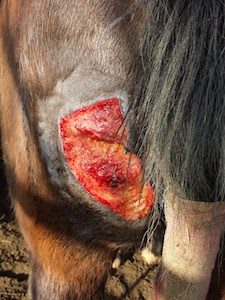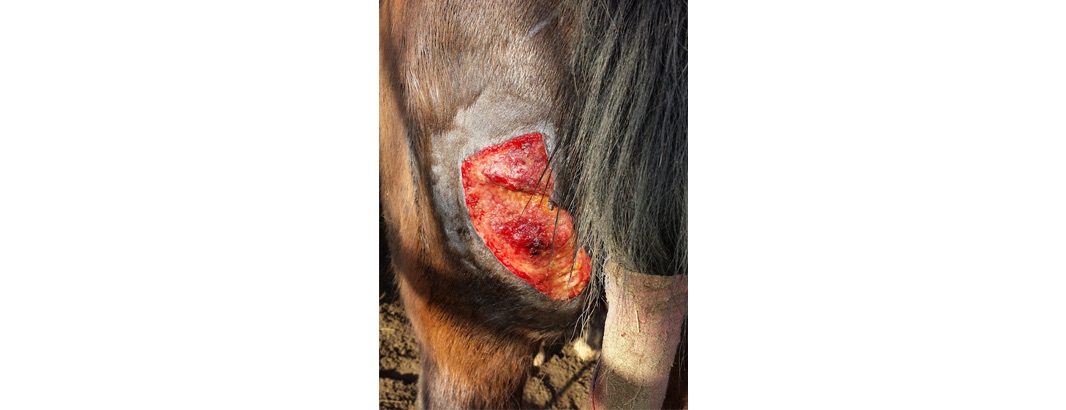First Do No Harm
by Dave Sauter, DVM

Diligent horse owners can help prevent serious injuries and wounds in their horses. Proper fencing, building maintenance, and being attentive to potentially dangerous objects is an essential part of horsemanship. Despite our best efforts, wounds still happen.
Wound treatment knowledge and a well-equipped first aid kit will be welcome when an injury occurs. As in all medical situations, an important principle to follow is “do no harm.” With this in mind, this article will cover what should and should not be used on wounds.
Wounds Requiring Veterinary Care
For wounds that obviously need immediate veterinary attention, there are a few basic things to do until the vet arrives. Most importantly, be safe. Work in an area free of obstacles and be extra cautious moving and handling the horse. Keep all people on the same side of the horse and be defensive in how you approach the wound.
Use pressure to control bleeding. For the upper body, use direct pressure with bandage material, cotton, fabric, or whatever you can find. For the extremities, use a pressure bandage. If it bleeds through the bandage, add more layers. Platelets and clotting factors work to form clots to stop the bleeding, so it’s better to leave the soaked layer in place rather than disrupt the developing clot on the wound surface.
If the wound is contaminated with dirt, hose it with running water to clean it. Cold water also helps reduce pain and swelling.
Treating Less Severe Wounds
To evaluate wounds further and to decide whether to have the vet come out, it is helpful to clip the hair around the wound with a #40 blade – but do this only if you can do it safely. Put water soluble sterile lube (from your first aid kit) into the wound before clipping. The clipped hair will stick to the lube instead of the wounded tissue and can later be rinsed off. Often wounds look worse after clipping the hair; clipping allows a really good look at the damage to see if it will need sutures. Nowadays, it is easy to take a few pictures (make sure they are in focus!) and text them to your vet to get his or her opinion.
Whenever handling wounds, wear clean exam gloves. This is important protection for both you and the horse. Gloves protect the wound from contaminants and bacteria on your hands. They also protect you from pathogens that might be present in infected wounds, such as MRSA and pseudomonas.
Irrigating Wounds
The solution to pollution is dilution. Irrigation does help remove contamination, wound discharge, and dead tissue. Tap water is hypotonic and causes tissue edema; sterile saline is a better choice. Sterile saline in one liter bags can be supplied by your veterinarian or you can make it yourself by adding 2 teaspoons of table salt to 1 liter of boiled water (preferably distilled water).
Using full force with a 35 cc syringe and an 18 gauge by 1.5-inch needle will produce a nice water jet that is a safe pressure for tissue irrigation. With the jet effect, you have control to aim the stream at the wound and there is no need to be close to the wound. In fact, it is safer to keep the needle far away in case the horse moves suddenly.
Disinfectants
Mild soap, such as Ivory, can be used to clean wounds with lots of discharge. Clean gently. There are also pharmaceutical grade surfactant wound cleansers available. Whichever you use, all of the surfactant has to be thoroughly rinsed off after finished cleaning. It is only meant to help remove discharge and is damaging to the wound tissues if left on. Non-woven gauze is less abrasive than woven gauze, and a better choice to clean with.
Betadine (povidone-iodine) and chlorhexidine antiseptics have all lost favor with experts for use on wounds. They do more harm to the wound than benefit from disinfecting. Likewise, hydrogen peroxide does not disinfect well and can be damaging to tissues.
Solutions and Soaks
For wounds with a lot of discharge and dead tissue that needs to slough away, hypertonic saline dressings, such as Curasalt, help draw out discharge and necrotic tissue. Homemade hypertonic saline can be made by adding 9 teaspoons of table salt to ½ cup of boiled water (preferably distilled water). Consult your veterinarian before using this type of dressing.
Sugardyne (made from povidone-iodine or Betadine and sugar) and honey, especially Manuka honey, are effective against bacteria. Be cautious with these; once the sugar is diluted enough from the wound discharge, it can then promote bacterial growth. Change the dressing often and thoroughly rinse off the old medication to prevent this.
Vinegar soaks can be used on badly infected wounds, especially wounds infected with pseudomonas. Pseudomonas is a particularly nasty bacterium and creates a sickly-sweet odor and sometimes a green pigment. Soak the affected area for 15 minutes once a day, then thoroughly rinse. The vinegar soak can be made by (no colon, no bullet) adding 1-part household vinegar to 8 parts boiled water (preferably distilled water) or half a cup vinegar to one quart of water.
Topical Medications
Triple antibiotic ointment is a good choice, especially in the early stages. Nitrofurazone however, retards wound healing. Avoid using any of the topical spray medications during the early stages of wound treatment. Later, once good granulation tissue has formed, AluSpray works nicely. Containing aerosolized aluminum, it makes a thin layer that forms a metallic covering over the wound.
Wound treatment is really a process. Wounds go through many changes as they heal and we have to change our methods depending on what stage the wound is in. At all stages, we want to make sure whatever we put on wounds is something that will help and not do any harm.
Originally Published February 2017 Issue

Dave Sauter is a Minnesota native and graduated from the University of Minnesota in 1987. Following graduation he interned at Rood and Riddle Equine Hospital in Lexington, Kentucky. After this internship, he continued to work exclusively with horses for another five years in Kentucky before moving out West and joining Kulshan Veterinary Hospital in Lynden, WA. He is a member of the AAEP, AVMA and the WSVMA. For more information about Kulshan Veterinary Hospital call 360-354-5095 or email [email protected]. www.KulshanVet.com






